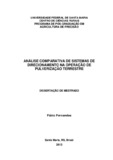| dc.creator | Fernandes, Fábio | |
| dc.date.accessioned | 2016-02-23 | |
| dc.date.available | 2016-02-23 | |
| dc.date.issued | 2013-12-30 | |
| dc.identifier.citation | FERNANDES, Fábio. Comparative analysis of systems of direction in the operation of spraying by land. 2013. 62 f. Dissertação (Mestrado em Agronomia) - Universidade Federal de Santa Maria, Santa Maria, 2013. | por |
| dc.identifier.uri | http://repositorio.ufsm.br/handle/1/4811 | |
| dc.description.abstract | With the agricultural mechanization in expansion in the country, a lot of farmers, in order to optimize resources in the property, invest in technologies and agriculture techniques of precision for decreasing the cost of production, turning this activity into something feasible to their businesses. The objective of the present study was to run a comparative analysis between two direction systems, one of them without precision orientation, guided by the operator and the other system using resources of an automatic pilot, in order to limit through field tests the overlapping in the application of chemicals generated during the traffic of the group tractor plus sprayer. The spraying tests were run in a rectangular field of 20 hectares, all the circuit of movement of the group tractor plus sprayer followed the operation process back and forth with maneuvers on the heads of the field with previous alignment in each line of application. To be possible to obtain the medium overlapping of the width of the sprayer bar of 18 meters on both systems of direction, about 192 points average were collected throughout each strip, reaching the value of overlapping to the system without precision orientation of 9.48% and 0.44% for the automatic pilot system. From these data, the number of necessary transversal lines was presented for each of the systems of direction to attend to the experimental area, making it possible to estimate the total expenses and the cost reduction per hectare. Saving 17.61 R$ per hectare, it is possible to say that the investment of R$ 64,145.43 (sixty-four thousand, one hundred and forty-five reais and forty-three cents), referring to the acquisition of the system of automatic pilot, it is feasible for the studied property of 1300 hectares, for a period of amortization of 10 years referring to the life span of equipment involved (tractor and sprayer). | eng |
| dc.format | application/pdf | por |
| dc.language | por | por |
| dc.publisher | Universidade Federal de Santa Maria | por |
| dc.rights | Acesso Aberto | por |
| dc.subject | Agricultura de precisão | por |
| dc.subject | Piloto automático | por |
| dc.subject | Redução de custo | por |
| dc.subject | Precision agriculture | eng |
| dc.subject | Automatic pilot | eng |
| dc.subject | Cost reduction | eng |
| dc.title | Análise comparativa de sistemas de direcionamento na operação de pulverização terrestre | por |
| dc.title.alternative | Comparative analysis of systems of direction in the operation of spraying by land | eng |
| dc.type | Dissertação | por |
| dc.description.resumo | Com a mecanização agrícola em expansão no pais, muitos produtores rurais, afim de otimizar recursos na propriedade, investem em tecnologias e técnicas de agricultura de precisão para uma diminuição do custo de produção, tornando esta atividade economicamente viável para os seus negócios. O objetivo do presente trabalho foi realizar uma análise comparativa, entre dois sistemas de direcionamento, um sem orientação de precisão, guiado pelo operador e o outro sistema utilizando recursos de um piloto automático, afim de delimitar por meio de testes de campo a sobreposição na aplicação de agrotóxico gerado durante o trafego do conjunto trator mais pulverizador. Os testes de pulverização foram realizados em um campo retangular de 20ha, todo circuito de deslocamento do conjunto trator mais pulverizador seguiu o processo de operação vai e vem com manobras nas cabeceiras do talhão com alinhamento prévio antes de cada linha de aplicação. Para que fosse possível obter a sobreposição média da largura da barra do pulverizador de 18m de ambos os sistemas de direcionamento, foram coletados em média 192 pontos de medidas ao longo de cada faixa, chegando ao valor de sobreposição para o sistema sem orientação de precisão de 9,48% e de 0,44% para o sistema de piloto automático. A partir destes dados, foi apresentado o número de linhas transversais necessárias para cada um dos sistemas de direcionamento para atender a área experimental, tendo assim como estimar os gastos totais e a redução de custos por hectare. Com a economia de R$/ha 17,61, é possível afirmar que o investimento de R$ 64.145,43 (Sessenta e quatro mil cento e quarenta e cinco reais com quarenta e três centavos), referente a aquisição do sistema de piloto automático, é viável para a propriedade estudada de 1300 hectares, para um período de amortização de 10 anos referente à vida útil dos equipamentos envolvidos (trator e pulverizador). | por |
| dc.contributor.advisor1 | Brandelero, Catize | |
| dc.contributor.advisor1Lattes | http://lattes.cnpq.br/4097216516218295 | por |
| dc.contributor.referee1 | Russini, Alexandre | |
| dc.contributor.referee1Lattes | http://lattes.cnpq.br/4912380699178131 | por |
| dc.contributor.referee2 | Medeiros, Fabrício Ardais | |
| dc.contributor.referee2Lattes | http://lattes.cnpq.br/5735475748810558 | por |
| dc.creator.Lattes | http://lattes.cnpq.br/2492603675075406 | por |
| dc.publisher.country | BR | por |
| dc.publisher.department | Tecnologia em Agricultura de Precisão | por |
| dc.publisher.initials | UFSM | por |
| dc.publisher.program | Programa de Pós-Graduação em Agricultura de Precisão | por |
| dc.subject.cnpq | CNPQ::CIENCIAS AGRARIAS::AGRONOMIA | por |


